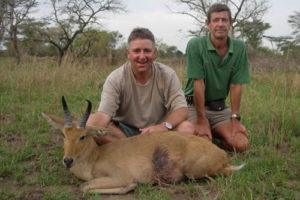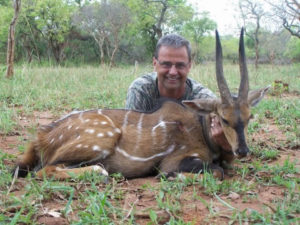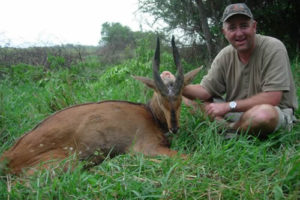Uganda is an amazing country for a safari. Winston Churchill once described Uganda as the “Pearl of Africa” while on a hunting expedition in Africa. Since the visit of the former British Prime Minister, Uganda has received other famous game hunters like Theodore Roosevelt and Walter Maitland Bell – also nicknamed “Karamojo” Bell. Walter is regarded as the greatest game hunter to visit Uganda because of his great expedition in Karamoja in the early 1900’s. Uganda is blessed with great biodiversity and particularly wildlife. She is home to the largest population of Mountain Gorillas. She has all of the big five plus some endemic species like the Jackson’s Hartebeest and the Uganda Kob.
Uganda has enormous potential for sport hunting. Sport hunting or Trophy hunting has had mixed success in the county. Trophy hunting refers to the regulated hunting of animals with special features  like large horns. Trophy hunting is a controversial subject globally. Many assume that sport hunting is one of the causes of the declining population of wild animals in Africa. The sport is restricted in many countries.
like large horns. Trophy hunting is a controversial subject globally. Many assume that sport hunting is one of the causes of the declining population of wild animals in Africa. The sport is restricted in many countries.
However, when well-managed, trophy hunting has several positive benefits to conservation. It helps in controlling population explosions among certain species especially antelope. In countries were the population of herbivores is high, overgrazing becomes a serious problem. When this happens animals tend to go out of reserves/parks to feed on human gardens. Sport hunting helps eliminate weak and old animals. Sport hunting is also known to help reduce on animal poaching especially when the poachers are employed as Guides and animal trackers. The money that is collected from game hunters can be channeled back into other wildlife conservation programs or to help communities living close to the hunting areas. When communities benefit from the revenue generated from sport hunting, they are less inclined to hurt the animals. Poachers are discouraged from illegal hunting when offered jobs as Guides and trackers.
Tanzania is an example of a country that has benefited from sport hunting in East Africa. The sport brings over 80 million US dollars to the country’s economy each year. The money got from the sport is channeled to wildlife conservation activities and to employ communities living close to the hunting grounds. Tanzania faced great criticisms when she allowed lion hunting even though she had (still has) the highest population of lions on earth (40%). The other top sport hunting countries are Canada, South Africa, Namibia, Mexico, Zimbabwe, New Zealand, Argentina, Zambia and Botswana. Tanzania has showed that if the sport is well regulated and monitored it can benefit a country and have a positive impact on wildlife conservation. Positive for wildlife conservation efforts because it motivates communities and private land owners to restore the wildlife and maintain the numbers. Sport hunting is impractical in many African countries because of corruption, poor governance and a lack of transparency in how things are done. How is the sport hunting in Uganda?
 Uganda lost a lot of wild animals during the civil wars between 1981 and 86. But that was not the beginning. The animal population in Uganda had started dwindling much earlier (in the 1970’s). More recently the Kony rebellion created an insurgency in northern part of the country. Peace returned to all parts of the country 15 years ago and the animal population is thriving once again. In some districts, the animal population has exploded so much that they have become a burden to farmers living close to reserves, game parks and hunting grounds. The wild animals disrupt domestic animal grazing routes while also damaging crops.
Uganda lost a lot of wild animals during the civil wars between 1981 and 86. But that was not the beginning. The animal population in Uganda had started dwindling much earlier (in the 1970’s). More recently the Kony rebellion created an insurgency in northern part of the country. Peace returned to all parts of the country 15 years ago and the animal population is thriving once again. In some districts, the animal population has exploded so much that they have become a burden to farmers living close to reserves, game parks and hunting grounds. The wild animals disrupt domestic animal grazing routes while also damaging crops.
Uganda’s animal population is enough to support game hunting in carefully controlled manner. But there is always that fear of corrupt government officials mismanaging the issuance of hunting concessions and licenses. In fact, the Uganda Wildlife Authority has cancelled hunting concessions several times after questioning its own decisions to allow the sport. In 2010, the Uganda Wildlife Authority released a statement prohibiting all forms of trophy hunting claiming that the profits from the sport where not enough to help with animal conservation or even stop poaching.
The example of Tanzania can be followed by Uganda if she wishes to get the best from game hunting. For example, in Tanzania younger animals are not included in the groups to be hunted. A strict quota is followed even for the aged groups. The authorities arrive at the quotas only after undertaking a census of the animals in the particular hunting zone.
Where to do Sport Hunting in Uganda
Uganda has three types of hunting areas – private land, communal hunting areas and national game reserves. The communal hunting areas operate independently like private land. Sport hunting in Uganda is not well developed. The road networks in some of the hunting areas are particularly worrying. Most sport hunting is done at the Ssese Islands (for Sitatunga), East Madi Wildlife Reserve, Ajai Wildlife Reserve, Kabwoya reserve and also in Karamoja.
In the Ssese Islands, hunting is done in the company of about 10 escorts (beaters). These former poachers are hired because of their hunting skills and vast knowledge of the area. In Kabwoya Wildlife Reserve (Hoima), one can hunt buffaloes, oribi, warthogs, bushbucks, Jackson’s hartebeest, Bush  Duikers and the Uganda Kob. Sport hunting is also organized at the Ajai Wildlife Reserve. This reserve is managed by Uganda Wildlife Safaris. The owner of Uganda Wildlife Safaris also has rights to other communal hunting grounds in Monor and Nakasongola. The Karamoja plains provide some of the best sport hunting ground in Uganda. The hunting is done in Matheniko, Bokara, Pian Upe Wildlife Reserves and all the way to Karenga near South Sudan. The main animals hunted are oribi, elephants, waterbuck and buffalo. Other hunting areas are around Lake Mburo National Park, Kaiso -Tonya Community Wildlife Area and Lipan Community Wildlife Areas (Kitgum). It is also worth mentioning Amudat, Iriri, Rwengara and Karenga Community Wildlife Areas. In most of these hunting areas, about 70 percent of the proceeds and game meat go back to the community. The participating hunters can take the hides, horns and skins. The general cost of shooting a leopard is $2000, a hippo is $1000 and a hyena is $100.
Duikers and the Uganda Kob. Sport hunting is also organized at the Ajai Wildlife Reserve. This reserve is managed by Uganda Wildlife Safaris. The owner of Uganda Wildlife Safaris also has rights to other communal hunting grounds in Monor and Nakasongola. The Karamoja plains provide some of the best sport hunting ground in Uganda. The hunting is done in Matheniko, Bokara, Pian Upe Wildlife Reserves and all the way to Karenga near South Sudan. The main animals hunted are oribi, elephants, waterbuck and buffalo. Other hunting areas are around Lake Mburo National Park, Kaiso -Tonya Community Wildlife Area and Lipan Community Wildlife Areas (Kitgum). It is also worth mentioning Amudat, Iriri, Rwengara and Karenga Community Wildlife Areas. In most of these hunting areas, about 70 percent of the proceeds and game meat go back to the community. The participating hunters can take the hides, horns and skins. The general cost of shooting a leopard is $2000, a hippo is $1000 and a hyena is $100.
The Uganda Wildlife Authority is also partnering with companies like the Aswa-Lolim Wildlife Association and the Uganda Wildlife Safaris to restock the animal population in northern Uganda for antelopes, waterbucks, buffaloes, warthogs and Hartebeest. This has been done by relocating some from the Murchison Falls National Park where they are in plenty. A partnership was signed between the government and the Aswa-Lolim Wildlife Association to introduce sport hunting in Amuru. The organization will hire poachers as Guides hoping that it will discourage them from illegal poaching. Only weak and old animals will be hunted.
Things to know about sport hunting in Uganda
- Before entering Uganda, one needs to secure a hunting license and permit to import rifles into the country. The Authorities charge a conservation fee of about $110 per day and a non-hunter fee of $40 per day.
- Uganda has two rainy and dry seasons. Hunting is done throughout the year but the best time for the sport is during the dry season – December to February. During this period, the grass is short making it easier to locate antelopes and buffalo. The rainy period between March and May is not very suitable for hunting because the hunting areas are filled with mud and the vegetation becomes too thick presenting many challenges to hunters.
- Hunters are allowed to bring two rifles at most into the country. The amount of ammunition is not regulated but each airline may have its own policies on firearms. Sixty rounds of ammunition would be enough for a light rifle while larger rifles may need 20 rounds. The authorities in Uganda do not allow automatic guns, semi-automatic guns or handguns. No silencers are permitted.
- If a hunter chooses not to bring their own rifles, they can hire some locally at a cost. You need to know which models are available before booking a hunting safari.
- Trophy hunting is a potentially dangerous sport. It is important to arrange your own Travel and Health insurance. This will cover you in case of any eventual medical evacuations.
- Apart from health insurance, you need to also ensure that all your firearms are insured before traveling to Uganda. Your application for importing firearms should be made several months in advance if possible so that you have the necessary documentation when you arrive in Uganda. All permits and licenses must be carried and presented at the airport so that you do not have any issues with immigration and customs.
Cost of a hunting safari in Uganda
An African safari is often perceived as an expensive activity. But that is not the case especially when compared to hunting in Europe or North America. The most expensive animals to hunt are the big five including buffaloes and leopards. The more reasonably priced hunting expeditions are for antelopes like gazelle, impala, wildebeest, kudus and eland. Trips to hunt Warthogs and zebras are also considered less expensive.
What about Uganda specifically? Hunting trips to Uganda are among the least expensive in Africa. For every safari you need to consider spending on meals, accommodation, trackers and Guides. In Uganda, hunting impalas, elands and impala would each cost about $800. Zebras cost $600. Most of the other antelopes fall below $500.
Packing list for a hunting safari in Uganda
In order to have the best hunting trip, you need to come prepared. A packing list for a sport hunting trip should include:-
Clothing: These should include T-shirts, long sleeved shirts, sweatshirts, khaki shorts, stockings, underwear, belts, caps, swimwear, a raincoat, waterproof jackets, hiking boots, hunting waders, sandals and flip flops.
Hunting gear: You need to travel with a camera, binoculars, a knife, hunting backpack, ammo belt, hunting gaiters, flashlights, insect repellents and leggings.
Documents: Do not forget to travel with your personal document, airline tickets, passport, documentation for rifle import, any letters of invitation and contact lists in case of any emergencies. It is important to also move with your yellow fever vaccination card in order to be allowed entry into the country. Visas can be secured from the airport or online before arriving into the country.
Items of a personal nature: These include sunscreen, reading glasses, sun glasses, money, toiletries, any medical prescriptions, cellphones, power adapters, reading books and chargers.
Accommodation during Sport hunting
While hunting in Uganda, the lodges are built in form of standard cottages, bands or mobile tents. The choice of accommodation depends on a hunter’s budget. Almost all the lodges provide breakfast, lunch and dinner each day. Here are some of the best lodges to book with while on a hunting trip in Uganda.
Mayanja River Lodge: This lodge is found in Nakaseke District along the banks of river Mayanja and close to River Kafu. River Mayanja has arguably the highest density of Sitatunga in Africa. The University of Alberta has carried out several studies on Sitatunga in this area. Mayanja River Loge is the perfect place to stay while hunting in this area. The Lodge has four luxury tents. The lodge has a well-stocked bar, a lounge area and a fireplace. The furniture used is made locally by hand. All rooms have free Wi-Fi available.
Karenga Camp: This camp is found close to the main gate (park entrance) of Kidepo Valley National Park. It is also close to the main airstrip in the park. The camp has 6 self-contained tent each with its own bathroom, shower and personal work space. It is built to allow residents go for game drives in Kidepo National Park, track game, visit the Karamojong and go for nature walks during the day.
Karimojong Overland Safaris Camp: With the recent introduction of sport hunting in Pian Upe Game reserve, this camp has become the perfect base for any would be hunter to this part of Uganda. The camp is built close to the offices of the Uganda Wildlife Authority in Moruajore. The camp offers 4 tents built on raised platforms offering en suite facilities including hot and cold water. The hunting areas are only two hours drive after the facility.

